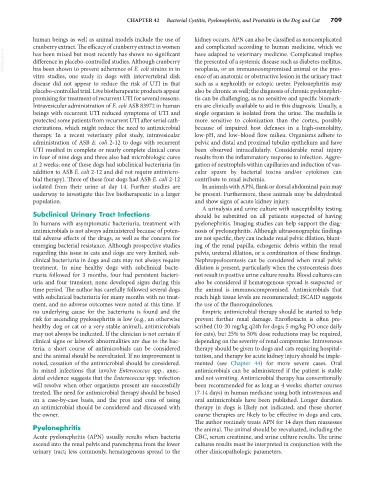Page 737 - Small Animal Internal Medicine, 6th Edition
P. 737
CHAPTER 42 Bacterial Cystitis, Pyelonephritis, and Prostatitis in the Dog and Cat 709
human beings as well as animal models include the use of kidney occurs. APN can also be classified as noncomplicated
cranberry extract. The efficacy of cranberry extract in women and complicated according to human medicine, which we
VetBooks.ir has been mixed but most recently has shown no significant have adapted to veterinary medicine. Complicated implies
the presented of a systemic disease such as diabetes mellitus,
difference in placebo-controlled studies. Although cranberry
has been shown to prevent adherence of E. coli strains in in
ence of an anatomic or obstructive lesion in the urinary tract
vitro studies, one study in dogs with intervertebral disk neoplasia, or an immunocompromised animal or the pres-
disease did not appear to reduce the risk of UTI in that such as a nephrolith or ectopic ureter. Pyelonephritis may
placebo-controlled trial. Live biotherapeutic products appear also be chronic as well; the diagnosis of chronic pyelonephri-
promising for treatment of recurrent UTI for several reasons. tis can be challenging, as no sensitive and specific biomark-
Intravesicular administration of E. coli ASB 83972 in human ers are clinically available to aid in this diagnosis. Usually, a
beings with recurrent UTI reduced symptoms of UTI and single organism is isolated from the urine. The medulla is
protected some patients from recurrent UTI after serial cath- more sensitive to colonization than the cortex, possibly
eterizations, which might reduce the need to antimicrobial because of impaired host defenses in a high-osmolality,
therapy. In a recent veterinary pilot study, intravesicular low-pH, and low–blood flow milieu. Organisms adhere to
administration of ASB E. coli 2-12 to dogs with recurrent pelvic and distal and proximal tubular epithelium and have
UTI resulted in complete or nearly complete clinical cures been observed intracellularly. Considerable renal injury
in four of nine dogs and three also had microbiologic cures results from the inflammatory response to infection. Aggre-
at 2 weeks; one of these dogs had subclinical bacteriuria (in gation of neutrophils within capillaries and induction of vas-
addition to ASB E. coli 2-12 and did not require antimicro- cular spasm by bacterial toxins and/or cytokines can
bial therapy). Three of these four dogs had ASB E. coli 2-12 contribute to renal ischemia.
isolated from their urine at day 14. Further studies are In animals with APN, flank or dorsal abdominal pain may
underway to investigate this live biotherapeutic in a larger be present. Furthermore, these animals may be dehydrated
population. and show signs of acute kidney injury.
A urinalysis and urine culture with susceptibility testing
Subclinical Urinary Tract Infections should be submitted on all patients suspected of having
In humans with asymptomatic bacteriuria, treatment with pyelonephritis. Imaging studies can help support the diag-
antimicrobials is not always administered because of poten- nosis of pyelonephritis. Although ultrasonographic findings
tial adverse effects of the drugs, as well as the concern for are not specific, they can include renal pelvic dilation, blunt-
emerging bacterial resistance. Although prospective studies ing of the renal papilla, echogenic debris within the renal
regarding this issue in cats and dogs are very limited, sub- pelvis, ureteral dilation, or a combination of these findings.
clinical bacteriuria in dogs and cats may not always require Nephropyelocentesis can be considered when renal pelvic
treatment. In nine healthy dogs with subclinical bacte- dilation is present, particularly when the cystocentesis does
riuria followed for 3 months, four had persistent bacteri- not result in positive urine culture results. Blood cultures can
uria and four transient; none developed signs during this also be considered if hematogenous spread is suspected or
time period. The author has carefully followed several dogs the animal is immunocompromised. Antimicrobials that
with subclinical bacteriuria for many months with no treat- reach high tissue levels are recommended; ISCAID suggests
ment, and no adverse outcomes were noted at this time. If the use of the fluoroquinolones.
no underlying cause for the bacteriuria is found and the Empiric antimicrobial therapy should be started to help
risk for ascending pyelonephritis is low (e.g., an otherwise prevent further renal damage. Enrofloxacin is often pre-
healthy dog or cat or a very stable animal), antimicrobials scribed (10-20 mg/kg q24h for dogs; 5 mg/kg PO once daily
may not always be indicated. If the clinician is not certain if for cats), but 25% to 50% dose reductions may be required,
clinical signs or labwork abnormalities are due to the bac- depending on the severity of renal compromise. Intravenous
teria, a short course of antimicrobials can be considered therapy should be given to dogs and cats requiring hospital-
and the animal should be reevaluated. If no improvement is ization, and therapy for acute kidney injury should be imple-
noted, cessation of the antimicrobial should be considered. mented (see Chapter 44) for more severe cases. Oral
In mixed infections that involve Enterococcus spp., anec- antimicrobials can be administered if the patient is stable
dotal evidence suggests that the Enterococcus spp. infection and not vomiting. Antimicrobial therapy has conventionally
will resolve when other organisms present are successfully been recommended for as long as 4 weeks; shorter courses
treated. The need for antimicrobial therapy should be based (7-14 days) in human medicine using both intravenous and
on a case-by-case basis, and the pros and cons of using oral antimicrobials have been published. Longer duration
an antimicrobial should be considered and discussed with therapy in dogs is likely not indicated, and these shorter
the owner. course therapies are likely to be effective in dogs and cats.
The author routinely treats APN for 14 days then reassesses
Pyelonephritis the animal. The animal should be reevaluated, including the
Acute pyelonephritis (APN) usually results when bacteria CBC, serum creatinine, and urine culture results. The urine
ascend into the renal pelvis and parenchyma from the lower cultures results must be interpreted in conjunction with the
urinary tract; less commonly, hematogenous spread to the other clinicopathologic parameters.

